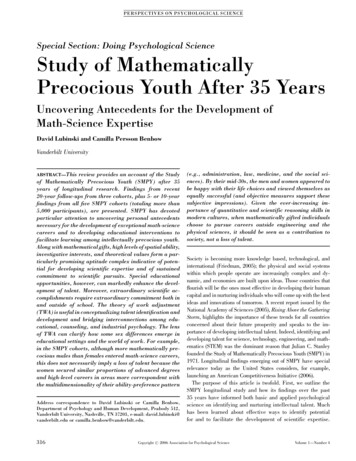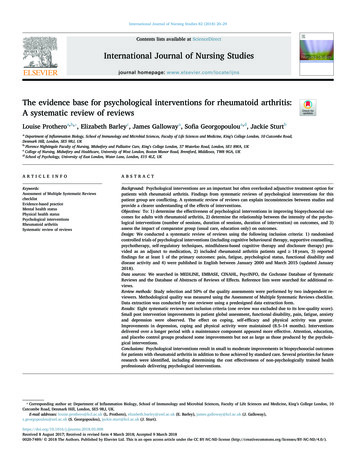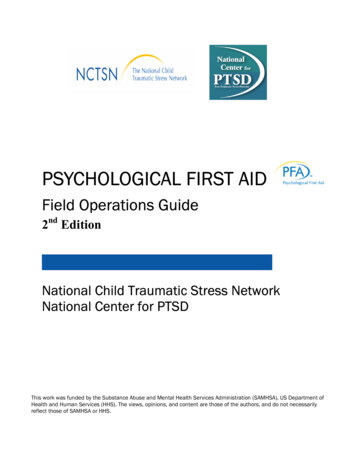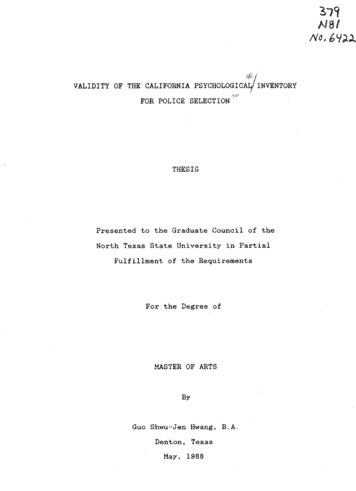
Transcription
PE R SP EC TI V ES O N P SY CH O L O G I CA L S CIE N CESpecial Section: Doing Psychological ScienceStudy of MathematicallyPrecocious Youth After 35 YearsUncovering Antecedents for the Development ofMath-Science ExpertiseDavid Lubinski and Camilla Persson BenbowVanderbilt UniversityABSTRACT—Thisreview provides an account of the Studyof Mathematically Precocious Youth (SMPY) after 35years of longitudinal research. Findings from recent20-year follow-ups from three cohorts, plus 5- or 10-yearfindings from all five SMPY cohorts (totaling more than5,000 participants), are presented. SMPY has devotedparticular attention to uncovering personal antecedentsnecessary for the development of exceptional math-sciencecareers and to developing educational interventions tofacilitate learning among intellectually precocious youth.Along with mathematical gifts, high levels of spatial ability,investigative interests, and theoretical values form a particularly promising aptitude complex indicative of potential for developing scientific expertise and of sustainedcommitment to scientific pursuits. Special educationalopportunities, however, can markedly enhance the development of talent. Moreover, extraordinary scientific accomplishments require extraordinary commitment both inand outside of school. The theory of work adjustment(TWA) is useful in conceptualizing talent identification anddevelopment and bridging interconnections among educational, counseling, and industrial psychology. The lensof TWA can clarify how some sex differences emerge ineducational settings and the world of work. For example,in the SMPY cohorts, although more mathematically precocious males than females entered math-science careers,this does not necessarily imply a loss of talent because thewomen secured similar proportions of advanced degreesand high-level careers in areas more correspondent withthe multidimensionality of their ability-preference patternAddress correspondence to David Lubinski or Camilla Benbow,Department of Psychology and Human Development, Peabody 512,Vanderbilt University, Nashville, TN 37203, e-mail: david.lubinski@vanderbilt.edu or camilla.benbow@vanderbilt.edu.316(e.g., administration, law, medicine, and the social sciences). By their mid-30s, the men and women appeared tobe happy with their life choices and viewed themselves asequally successful (and objective measures support thesesubjective impressions). Given the ever-increasing importance of quantitative and scientific reasoning skills inmodern cultures, when mathematically gifted individualschoose to pursue careers outside engineering and thephysical sciences, it should be seen as a contribution tosociety, not a loss of talent.Society is becoming more knowledge based, technological, andinternational (Friedman, 2005); the physical and social systemswithin which people operate are increasingly complex and dynamic, and economies are built upon ideas. Those countries thatflourish will be the ones most effective in developing their humancapital and in nurturing individuals who will come up with the bestideas and innovations of tomorrow. A recent report issued by theNational Academy of Sciences (2005), Rising Above the GatheringStorm, highlights the importance of these trends for all countriesconcerned about their future prosperity and speaks to the importance of developing intellectual talent. Indeed, identifying anddeveloping talent for science, technology, engineering, and mathematics (STEM) was the dominant reason that Julian C. Stanleyfounded the Study of Mathematically Precocious Youth (SMPY) in1971. Longitudinal findings emerging out of SMPY have specialrelevance today as the United States considers, for example,launching an American Competitiveness Initiative (2006).The purpose of this article is twofold. First, we outline theSMPY longitudinal study and how its findings over the past35 years have informed both basic and applied psychologicalscience on identifying and nurturing intellectual talent. Muchhas been learned about effective ways to identify potentialfor and to facilitate the development of scientific expertise.Copyright r 2006 Association for Psychological ScienceVolume 1—Number 4
David Lubinski and Camilla Persson BenbowBecause the work on educational facilitation has been summarized elsewhere (Benbow & Lubinski, 1996; Benbow &Stanley, 1996; Stanley, 2000),1 our second purpose is to focusattention on the critical personal antecedents for developingoutstanding scientific careers. Which individuals are mostlikely to become exceptional STEM professionals? We say lesshere on how to facilitate the educational development of suchindividuals.SMPY was not designed for, nor is this article about, enhancingthe scientific literacy of the general population. Enhancing scientific literacy is clearly important. The public needs to makeinformed decisions on topics ranging from whether evolutionshould be taught in the schools to whether tax dollars should beused to fund stem cell research. Fostering scientific literacy,however, is different from identifying future scientific leaders andcreating supportive environments for them. Although the twocertainly have common components, the talent and commitmentnecessary to develop as a scientific leader require both personalattributes and learning environments that are truly beyond thenorm. The intellectual abilities, personal commitment, and educational experiences needed to ameliorate global warming or tocreate an environmentally safe, oil-independent energy source areof a much different order of magnitude than those required fordeveloping scientific literacy (Simonton, 1994; Zuckerman, 1977).An overabundance of STEM leaders has emerged from SMPY.Their distinguishing psychological characteristics and the developmental choices structuring the paths they traversed from age 12have become evident from experiential and personal data collectedat earlier time points. Not surprisingly, the personal attributes offuture STEM leaders reveal that it takes much more than exceptional abilities to develop truly exceptional scientific expertise.SMPYSMPY was founded by Stanley on September 1, 1971, at JohnsHopkins University (Keating & Stanley, 1972; Stanley, 1996).The study moved to Iowa State University in 1986, and wasdirected by Camilla P. Benbow from 1986 to 1990; from 1991through 1998, we co-directed SMPY at Iowa State, and then in1998, we moved it to Peabody College of Vanderbilt University.The initial idea motivating SMPY was to conduct research whileproviding services to intellectually talented adolescents, particularly those with mathematical talent. The underlying philosophy driving this study is based on the best educationalpractices for all students, namely, ‘‘appropriate developmentalplacement’’ (Lubinski & Benbow, 2000, p. 138)—providingstudents with educational opportunities tailored to their rates oflearning (Benbow & Stanley, 1996; Colangelo, Assouline, &1Many findings from SMPY’s first decade have been reported in edited volumes published by the Johns Hopkins University Press (Benbow & Stanley,1983; Fox, Brody, & Tobin, 1980; George, Cohn, & Stanley, 1979; Keating,1976; Stanley, George, & Solano, 1977; Stanley, Keating, & Fox, 1974). Stanley’s Festschrift (Benbow & Lubinski, 1996) concluded this series (cf. Benbow& Lubinski, 2006; ‘‘In Appreciation,’’ 2005).Volume 1—Number 4Gross, 2004). In the words of Stanley (2000), the idea is to teachstudents ‘‘only what they don’t already know’’ (p. 216).From the beginning, SMPY focused as much on serving thesocial and emotional well-being of intellectually precociousyouth as on experimenting with differential opportunities forpromoting intellectual development (Benbow, Lubinski, &Suchy, 1996). To inform these two agendas, Stanley planned anafter-high-school follow-up that ultimately evolved into a50-year longitudinal study, which currently includes more than5,000 intellectually talented individuals identified over a 25year period (1972–1997). The aim of this research is to develop abetter understanding of the unique needs of intellectually precocious youth, the determinants of the varying developmentaltrajectories they display, and the role of education in talentdevelopment. ‘‘Study of Mathematically Precocious Youth’’ hasbecome a bit of a misnomer, however, because many of ourparticipants are more verbally than mathematically talented,and the participants are now all adults. Nevertheless, to maintain consistency, we have chosen not to rename the study.Above-Level Testing and Criteria Used to Identify SMPYParticipantsThe members of four of SMPY’s five cohorts were selected(primarily) at around age 12 or 13, when they were in the seventhor eighth grade (a fifth cohort of top math-science graduatestudents was identified for longitudinal study as well). The selection process was tiered: Almost all students were first required to earn scores within the top 3% on a conventionalachievement test routinely administered in their schools (e.g.,the Iowa Test of Basic Skills). This select group was then giventhe opportunity to take the SAT through a talent search (TS;Benbow & Stanley, 1996; Colangelo et al., 2004; Keating &Stanley, 1972; Stanley, 1996). The SATwas designed for collegebound high school juniors and seniors, to assess mathematical(SAT-M) and verbal (SAT-V) reasoning abilities critical forcollege work (Donlon, 1984). Because few of the potential cohortmembers had received formal training in algebra or more advanced mathematics, and because they were 4 to 5 yearsyounger than the population for whom the SAT was designed,this assessment falls into the category of above-level testing.SAT-M and SAT-V score distributions among seventh and eighthgraders in the top 3% are indistinguishable from the score distributions observed among high school students (Benbow, 1988).This finding is especially noteworthy for SAT-M, because despite alack of formal training in algebra, geometry, and other areas ofmath tested, several of these seventh and eighth graders scoreabove the admissions cutoff for many elite universities. Given theabstract nature of this measuring tool and the sheer novelty of theproblems for this population, the SAT functions at more of ananalytical reasoning level for these students than it does for olderstudents who have been explicitly exposed to SAT content throughcourse work in high school (Benbow, 1983; Stanley & Benbow,1986; Brody & Benbow, 1990; Minor & Benbow, 1996).317
Antecedents of Math-Science ExpertiseConventional age- or grade-based achievement tests routinelyadministered in schools are insensitive to much of the individualityof intellectually talented young adolescents. Normatively basedinstruments do not have high enough ceilings for these students,and most of their ability and achievement scores pile up at the top,with profile variation masked. This fosters an underappreciationnot only of their potential, but also of their unique strengths andrelative weaknesses. Superficial inferences based on such assessments amount to erroneous attributions of ‘‘multipotentiality,’’namely, that they are all equally good at everything and can doalmost anything (cf. Achter & Lubinski, 2005; Achter, Lubinski, &Benbow, 1996). In reality, this special population (like almost allspecial populations) contains an enormous amount of psychologicaldiversity, including diversity in relative strengths and weaknesses.Above-level tests offer the kind of measuring stick needed forassessing the learning rates of highly able students because suchtests can uncover the profound range of individual differences inlearning readiness that these students display. SMPY chose theSAT for this purpose, but other instruments can be used in thisway as well. The SAT’s high ceiling for this age group distinguishes the able from the exceptionally able and, simultaneously,assesses their relative math and verbal strengths. Capturing thelevel and pattern of their intellectual potential more preciselythan is possible with grade-level tests allows one to harness thenature and scope of their precocity to inform practice (Benbow &Stanley, 1996; Colangelo et al., 2004), research (Corno et al.,2002; Vale & Vale, 1969), and theory development (Lubinski,1996, 2000, 2004; Lubinski & Benbow, 2000; Underwood, 1975).For example, intellectually able adolescents scoring 500 orhigher on SAT-M or SAT-V before age 13 (top 1 in 200) canassimilate a full high school course (e.g., chemistry, English,mathematics) in 3 weeks at a summer residential program forintellectually precocious youth; yet exceptionally able adolescents, those scoring 700 or more (top 1 in 10,000), can assimilateat least twice this amount (Benbow & Stanley, 1996; Colangeloet al., 2004; Stanley, 2000).2 Above-level assessments are2That cognitive abilities can be enhanced through learning is, of course, true,but a common finding is that the relationship is not linear. When all students areprovided with opportunities to learn at their desired rate, those who begin withmore ability typically profit more from these opportunities (Ceci & Papierno,2005; Gagne, 2005; Jensen, 1991, p. 178; Kenney, 1975; Robinson, Abbott,Berninger, & Busse, 1996; Robinson, Abbott, Berninger, Busse, & Mukhopadhyah, 1997). This nonlinearity is intensified when one considers the fullrange of ability. Students with developmental delays assimilate much less thantypically developing students even in the best of conditions, yet this fanning outin achievement is observed throughout the ability spectrum and within thesepopulations as well (D. Fuchs et al., 2001; L.S. Fuchs, Fuchs, Karns, Hamlett,& Katzaroff, 1999). The idea that opportunities for optimal growth expand individual differences in achievement has been discussed periodically for decades (e.g., Pressey, 1946, 1955; Seashore, 1922; Thorndike, 1911; Thurstone,1948), yet it is conspicuously absent in many modern treatments. Two excellentexceptions, however, are articles by Ceci and Papierno (2005) and Gagne(2005). Ceci and Papierno depicted this phenomenon nicely by subtitling theirtreatment ‘‘When the ‘Have Nots’ Gain but the ‘Haves’ Gain Even More.’’ Withthis in mind, consider the following proposal for evaluating schools: ‘‘The goodschool, as I have suggested, does not diminish individual differences; it increases them. It raises the mean and increases the variance’’ (Eisner, 1999,p. 660).318critical, therefore, for properly structuring educational curriculaand being responsive to individuality. The exceptionally ablecertainly require different opportunities for optimal development than the able (Lubinski, Webb, Morelock, & Benbow,2001; Muratori et al., 2006), the former needing a more abstract,deeper, and faster-paced curriculum to avoid boredom. Furthermore, individual differences in learning rates between theable and the exceptionally able portend commensurate differences in occupational accomplishments many years later. Liketheir earlier academic accomplishments, the occupational accomplishments of the profoundly gifted tend to develop at anaccelerated pace and with greater depth. The profoundly giftedsimply have greater capacity for accomplishment and creativecontributions.In our 20-year follow-up studies of adolescents identified atage 12, for example, 30% of participants with SAT-M or SAT-Vscores of 500 or above secured doctorates, compared with 50%of those scoring 700 or above (Benbow, Lubinski, Shea, & Eftekhari-Sanjani, 2000; Lubinski, Benbow, Webb, & BleskeRechek, 2006). The base rate for earning a doctorate (i.e., J.D.,M.D., or Ph.D.) in the United States is 1%. That a 2-hr test canidentify 12-year-olds who will earn this ultimate educationalcredential at 50 times base-rate expectations is remarkable.Moreover, a 200-point difference in SAT scores at age 12 (500vs. 700) eventuates, by middle age, in marked differences inincome, patents earned, and tenure-track academic positionssecured at top U.S. universities (cf. Lubinski et al., 2006; Wai,Lubinski, & Benbow, 2005). More than one third of the abilityrange is found within the top 1% of ability, above-level testingaffords valid assessments of individual differences within thisrange, and these differences make a difference in school, work,and life. Models of exceptional human development need toincorporate these individual differences.The Five SMPY CohortsSMPY’s five cohorts were formed using different selection criteria (see Table 1). The first three cohorts are successively moreable (top 1.0%, 0.5%, and 0.01% in ability, respectively). Thefourth cohort consists of participants who met a top-3% criterion, but a large subset of these participants took the SAT at age12 or 13 and achieved scores within the top 0.5%. Finally, a fifthcohort consists of top first- and second-year graduate students inmath and science; they were selected for a retrospective test of,among other things, the fidelity of TS procedures for identifyingscientific talent. Collectively, these five cohorts include morethan 5,000 participants.THEORETICAL MODELGiven the number of variables facilitating the development oftalent, we used a model from counseling psychology to helporganize findings and structure our longitudinal research andVolume 1—Number 4
David Lubinski and Camilla Persson BenbowTABLE 1The Five Cohorts of the Study of Mathematically Precocious YouthCohortNYears whenidentifiedStudents’ agewhen 23–25Identification criteriaSAT-M 390 or SAT-V 370 (top 1 in 100)SAT-M 500 or SAT-V 430 (top 1 in 200)SAT-M 700 or SAT-V 630 (top 1 in 10,000)Top 3% on any subtest of a grade-level achievement testEnrollment as a 1st- or 2nd-year student in a graduate programat a top-ranked engineering, math, or science department inthe United StatesNote. SAT-M 5 score on the mathematics subtest of the SAT; SAT-V 5 score on the verbal subtest of the SAT. (Cutting scores wereestablished before the SAT-V was recentered in the mid-1990s.) The cutoffs selected for Cohort 1 represented the average performance ofa random sample of high school girls and also represented approximately the top 1% in ability when achieved by age 13. Participants weredrawn primarily from the state of Maryland, with a heavy concentration in the greater Baltimore area. Cohort 2 was drawn from the midAtlantic states, and Cohort 3 is national in its representation. Cohort 4 consisted primarily of Midwesterners; a subset of these participants, in addition to achieving a top-3% score on a subtest of a grade-level achievement test, also took the SAT and met at least one of thetop-0.5% criteria (i.e., SAT-V 430 or SAT-M 500). Talent-search participants have been or are to be followed up at ages 18, 23, 33,50, and 65. Cohorts 1, 2, and 3 have completed follow-ups through age 33 (Benbow, Lubinski, Shea, & Eftekhari-Sanjani, 2000; Lubinski,Benbow, Webb, & Bleske-Rechek, 2006). An age-50 follow-up of Cohort 1 will be launched in approximately 3 years. The age-18 follow-up(after high school) for Cohort 4 is complete (Webb, Lubinski, & Benbow, in press). A 10-year follow-up of Cohort 5 was conductedsimultaneously with the 20-year follow-up of Cohort 3 (Lubinski et al., 2006).educational interventions (Lubinski & Benbow, 2000). Specifically, we extended the theory of work adjustment (TWA; Dawis& Lofquist, 1984; Lofquist & Dawis, 1969, 1991) to educationand talent development (Lubinski & Benbow, 1992; Lubinski& Humphreys, 1990b), just as Katzell (1994) drew on TWAfor modeling phenomena in industrial-organizational psychology. From our point of view, the applied psychological precincts of educational, counseling, and industrial psychologymay be viewed sequentially from a life-span developmentalperspective (Scarr & McCartney, 1983). All three specialtiesinvolve the scientific study of how individual differences may beused to structure interventions or opportunities to enhancepositive psychological growth, but each area concentrates ona somewhat different stage of development. TWA organizesimportant variables common to all three areas (Lubinski &Benbow, 2000).TWA is predicated on devoting equal attention to assessingthe individual and assessing the environment (see Fig. 1). Theindividual’s learning or work personality is parsed into two majorcomponents, abilities and preferences (interests and values),whereas the environment is parsed into commensurate domainsof ability requirements (for meeting performance expectations)and reinforcer systems (for acknowledging and compensatingperformance). Profound individual differences in capability andmotivation exist within cultures and subcultures, and evenamong siblings (Lubinski, 2000, 2004; Murray, 1998; Rowe,1994; Scarr, 1996), and these differences eventuate in importantoutcome differences in education and the world of work. This iswhy assessing individual differences in psychological attributesis so important for both personal and professional development(Dawis, 1992, 2001; Lubinski, 1996; Roe, 1956, p. ii; Tyler,Volume 1—Number 41974; Williamson, 1965).3 According to TWA, educationalcommitment and occupational tenure are a joint function of twomajor dimensions of correspondence: satisfaction (correspondence between needs and rewards) and satisfactoriness (correspondence between ability and ability requirements). The former is determined subjectively (or intra-individually) bystudents and workers and is based on their feelings; the latter isdetermined objectively (or interindividually) by teachers andsupervisors and is based on performance.Satisfaction determines how much an individual is motivatedto maintain contact with a particular environment (commitmentto a discipline or occupation), whereas satisfactoriness determines how much the people in the environment who evaluateperformance are motivated to keep the person (or are committedto retaining the person). Both must be present for the individualto remain in the environment. If satisfaction is in place butsatisfactoriness is not, the person will be asked to leave (although the person may like to stay), whereas if the inverse is thecase, the person will choose to leave (although people in theenvironment may want to keep him or her). Satisfaction andsatisfactoriness determine the extent to which the person-environment relationship is likely to maintain harmony and reciprocally nurture personal and organizational developmentover extended time frames (resulting in lengthy tenure). (For3There are many different kinds of cognitive abilities, but it is generallyagreed that they are hierarchically organized (Carroll, 1993; Snow & Lohman,1989). In our treatment of specific abilities, we focus on those that are longitudinally stable and that have been shown to be widely generalizable in multiple contexts and to be related to individual differences in learning ineducational settings, as well as to learning and performance in the world ofwork.319
Antecedents of Math-Science ExpertiseFig. 1. The theory of work adjustment (TWA). In this framework, personal attributes (abilities and interests) and the environment (abilitiesrequirements and reinforcer system) are given equal emphasis; occupational tenure is a joint function of the correspondence between abilities andability requirements (satisfactoriness) and of the correspondence between interests and the reinforcer system (satisfaction). We have extended TWAto the domain of talent development. The diagrams on the left illustrate how cognitive abilities and interests have been conceptualized in our model(Lubinski & Benbow, 2000). In the diagram of the radex scaling of cognitive abilities, each region of concentration is denoted by a different letter,and higher numbers indicate increasing complexity. The diagram of Holland’s (1996) hexagon of interests (referred to as RIASEC, after the initialletters of the interests) shows a simplification following Prediger (1982); in this simplification, interests are modeled by a two-dimensional structureof independent dimensions: people-things and data-ideas.further information about this model and its extension to otherdomains, see Achter & Lubinski, 2003, 2005; Dawis, 2005;Dawis & Lofquist, 1984; Katzell, 1994; Lofquist & Dawis, 1991;and Lubinski & Benbow, 2000.)SMPY’S EMPIRICAL FINDINGSWe open this section by discussing cognitive abilities. First, wepresent descriptive data highlighting the individual differencesin cognitive ability among young adolescents in the top 1% ofquantitative reasoning ability and showing that these individualdifferences made a difference in education, the world of work,and creative accomplishments. We deal with this topic firstbecause there is a long-standing and widely held supposition ofan ‘‘ability threshold’’ in the scientific literature (i.e., an assumption that beyond a certain point, more ability does notmatter; Getzels & Jackson, 1962; Howe, 2001; Renzulli, 1986).Second, the psychological significance of ability pattern is explicated. After treating cognitive abilities, we discuss the incremental validity of adding preferences to ability assessmentfor modeling intellectual development more comprehensivelyand then review the importance of time devoted to work and timewilling to devote to work. Next, the role of special educational320programs and the developmental particulars of top math-sciencegraduate students are touched upon. A focus on the math-science pipeline is maintained throughout, but the personal attributes relevant to other kinds of expertise are also covered. Therole of sex differences is also a focus of the discussion, and weprovide an appendix with some normative data illustrating howsex differences in level and dispersion can collectively operateto create disparate male:female ratios at high as well as lowextremes of ability. And finally, a concluding section places ourmodel and longitudinal findings in a broader historical contextand underscores the importance of the developmental sciencesand human-capital initiatives incorporating concepts and findings from the study of individual differences.Cognitive AbilitiesAbility LevelThe statement that more than one third of the ability rangeis contained in the top 1% gives one pause initially, but consider the following for a familiar illustration. Modern talentsearches and educational programs for intellectually talentedstudents have moved well beyond IQ, but let us take IQ asa reference point. IQs in the top 1% begin at approximatelyVolume 1—Number 4
David Lubinski and Camilla Persson Benbowwhen reflected on later in life, engendered uniformly high ratings of satisfaction with educational and subsequent careerchoices, among both sexes (Benbow et al., 2000; Lubinski et al.,2006). By their mid-30s, both male and female participantsexpressed few regrets about their educational and careerchoices, and the nature of the regrets that were expressed did notcovary with sex.However, these three cohorts were identified over a 10-yearperiod, and their 20-year follow-ups were offset by the samenumber of years. Did cohort differences (as well as more ability)contribute to the greater educational achievement of the morerecent cohorts?To ascertain more precisely the importance of ability level, wejoined with Wai to conduct a within-cohort analysis of Cohorts 1and 2 (Wai et al., 2005). Using 20-year follow-up data, we compared students in the top and bottom quartiles for SAT-M scoreswithin the top 1%, by cohort and sex, on an array of outcomecriteria having both high ceilings and low base rates: earning adoctorate (J.D., M.D., or Ph.D.), earning a STEM Ph.D., earning ahigh income, securing a patent, and achieving tenure at a U.S.university ranked within the top 50. For the latter variable, weexamined the university Web sites of the academics in our sampleto ascertain who among them had achieved an associate professorship with tenure by the year 2004. ‘‘America’s Best Colleges2004’’ (2003) was used to generate a reasonable list of the top 50U.S. universities. Findings combined across cohorts and sexes arepresented in Figure 2.137 and extend beyond 200 (an IQ range of more than 63points is thus found in the top 1%). (The same phenomenonoccurs in physical measurements such as height and weight.)The important psychological question is, do ability differenceswithin the top 1% make a difference in life? To answer thisquestion, we examine educational credentials, occupationaloutcomes, and creative accomplishments as a function of SATM scores at age 13 (not all of our participants had SAT-V scoresavailable).Table 2 contains 20-year follow-up data from Cohorts 1 and 2(Benbow et al., 2000) and Cohort 3 participants with SAT-Mscores of 700 and above (Lubinski et al., 2006). All three cohortshad SAT-M means more than 100 points beyond the cuttingscore for the top 1% by age 13, but the three cohorts weresuccessively more able. Their mean SAT-M scores by age 13were as follows: 537 and 505 for Cohort 1 males and females,567 and 519 for Cohort 2 males and females, and 729 and 732for Cohort 3 males and females. By age 33, approximately 25%of Cohort 1 had secured doctorates, in comparison with morethan 30% for Cohort 2 and more than 50% for Cohort 3. Moreover, within each cohort, roughly equal proportions of males andfemales achieved advanced degrees, but the sexes were represented disproportionately across areas: Females were morelikely to secure degrees in the humanities, life sciences, andsocial sciences than in mathematics, computer science, engineering, and the physical sciences, whereas the reverse was truefor males. It should be noted, too, that these educational choices,TABLE 2Academic Credentials Secured by Age 33: Cohorts 1, 2, and 3Cohort 1 (840 males, 543 females)MajorMathematicsEngineeringComputer sciencePhysical sciencesBiological sciencesMedicine, healthSocial sciencesArts, humanitiesLawBusinessEducationOther fieldsCo
NationalAcademyofSciences(2005), Rising Above the Gathering Storm, highlights the importance of these trends for all countries concerned about their future prosperity and speaks to the im-portance of developing intellectual talent. Indeed, identifying and developi











